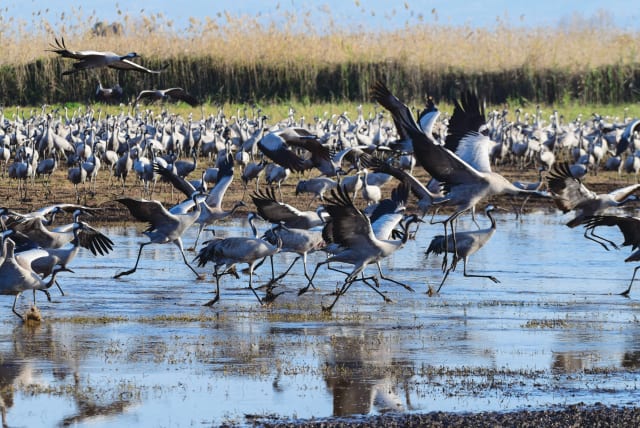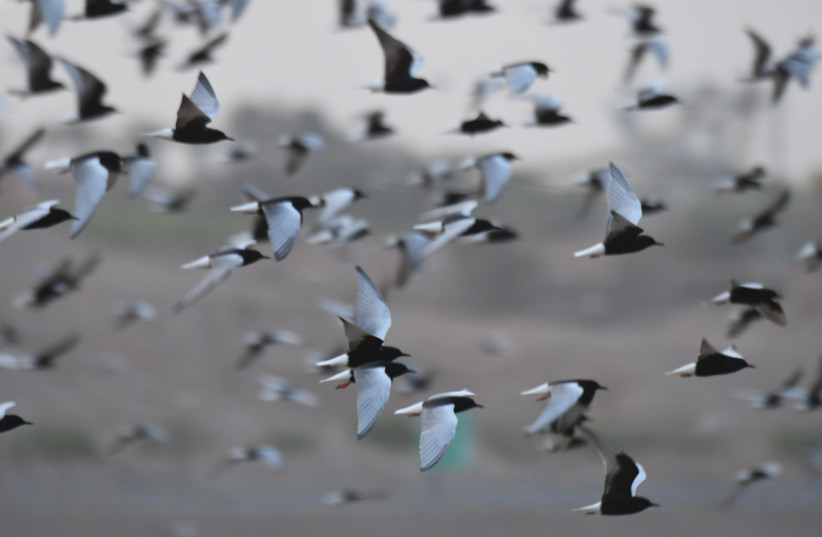Israel and the great bird migration: Can we save bird from extinction? - opinion

SPNI now wants to work with numerous kibbutzim to reestablish wetlands and build ecotourism sites across Israel.
When my family first moved to Israel, I remember one day I noticed a strange black cloud in an otherwise perfectly blue sky. The cloud moved quickly and in a strange pattern, backward and forward. I soon realized it was moving in formation. It wasn’t a cloud at all – it was thousands upon thousands of birds in the sky, all flying together on one perfect journey. Without realizing it, I had just witnessed the great bird migration.
Every year between late August and mid-December, half a billion birds – yes, half a billion – travel from Europe and Asia toward warmer climates in Africa, where there is more food. As they cross the Middle East, their last resting stop for a mere 3,000 km. is in Israel. So it’s absolutely crucial that during this stop, they are able to get enough food and water to sustain them as they continue on their journey for thousands of miles over the Sahara Desert in North Africa.
It’s not an overstatement to say that if these birds were to die on their journey, this would have an impact on ecosystems all over the world, which rely on the great bird migration.
One-eighth of all birds are threatened with extinction
Every four to five years, a nonprofit called BirdLife International publishes the State of the World’s Birds report. The organization focuses on birds because it says they are an excellent barometer for planetary health, revealing wider trends in natural ecosystems. The conclusions of its most recent assessment, which it published in 2022, are disturbing.
One-eighth of all birds around the world are at risk of becoming extinct, and almost 50% of all bird species are decreasing. This comes as a result of climate change and man’s overuse of nature’s resources, such as activities like non-sustainable agricultural practices and logging.
The proposed solution is known as “rewilding.” These are conservation efforts with the goal of restoring and protecting eco, or wilderness areas, as well as natural processes. Not only will this help to rebalance nature, but it is hoped that rewilding will save rare bird species from extinction.
Israel – a global center for biodiversity
One of the smallest countries in the world, Israel – and in particular, the Hula Valley in the North – is critical for the birds’ progress, and indeed for nature on three entire continents. The Hula Valley Lake, which is only 5 km. long, is a beautiful lake in the Upper Galilee. Visitors at the Hula Valley can watch hundreds of species of birds as they migrate south.
The lake was once drained, until KKL-JNF began the process of restoring it. Today, it not only sustains millions of birds and wetland wildlife every year, but it also attracts over 400,000 visitors, who come with their binoculars and cameras to watch, for example, the miracle of 40,000 cranes taking off at sunrise. It’s considered one of the best nature experiences in the world and annually generates $200 million for the area.
The success of restoring the Hula Valley shows that it is possible to reverse the harm done in the past. But that’s just the beginning.
From Start-Up Nation to Start-Up Nature
Israel is known as the Start-Up Nation thanks to its thriving hi-tech sector and world leading research and development. But many in the country are now applying Israel’s innovations and its people’s innovative spirit to restoring nature.
For 60 years, the Society for the Protection of Nature in Israel (SPNI) has been Israel’s top policy and planning conservation organization and has been deeply concerned about the country’s disappearing wetlands over time. This situation came about not only after Israel drained swamps to wipe out malaria-infected mosquitoes but also after much of the country’s 200,000 dunams of wetlands were taken over for agricultural purposes and to create fish farms.
Today, there are less than 20,000 dunams of wetlands left. To restore them, the SPNI has introduced the Start-Up Nature initiative. Start-Up Nature seeks to turn unused agricultural land into thriving wetland sanctuaries, preserving the important bird migration route, creating habitats for millions of creatures and – in the spirit of the Israeli start-up sector – no doubt generating millions for the economy in the process.
To kick off this initiative, Start-Up Nature set up an $11m. pilot project at Kfar Ruppin, a kibbutz in the Beit She’an Valley, also in the North. Having rewilded the reservoir there, it wasn’t long before dozens of species of birds and wildlife began to return to the area. The Kfar Ruppin Birding Park and Wetland Reserve officially opened in 2021.
A growing ambition
The SPNI now wants to work with numerous kibbutzim to reestablish wetlands and build ecotourism sites across the country. Its second pilot site has opened at Kibbutz Ma’agan Michael, which is located on the Mediterranean Sea coast between Haifa and Hadera. Plans include a 33-acre site with four ponds, a migration research station with the University of Haifa and an education center with walking trails, accommodating 150,000 visitors every year.
In July, the government approved a plan to clean up 37 km. of the Jordan River, restoring its wildlife, and creating further opportunities for the tourism sector. And at the UN’s recent COP27 Climate Summit at Sharm e-Sheikh in Egypt, Jordan and Israel signed a Declaration of Intent to clean up the Jordan River together. This is important for both countries, not only for its ecological value but also for its historical, religious and economic value.
The venture will require both countries to cooperate on the restoration, which will provide opportunities for diplomacy, employment and tourism, as well as improving the quality of life of local residents. In addition, Israel and Jordan have agreed to look into creating a regional center for research and academic cooperation and to restore streams that run into the river.
Restarting nature, restarting hope
If Israel’s plans continue at pace, it has a real opportunity to save millions of birds and serve as a global center for biodiversity, research and education. There’s a further environmental benefit too because wetlands are even better than forests at capturing and storing carbon. And they’re just as beautiful, helping to connect people across continents, connect people with nature, and connect people to our shared future.
BirdLife International concluded that “the next decade is critical if we are to stop unraveling the fabric of life and destroying our global safety net. Governments must adopt a Global Biodiversity Framework with ambitious commitments to ensure transformative change and urgent implementation of action. The future of the world’s birds and ultimately our own species depends upon it.”
It remains to be seen what the new government will do – that will certainly be a subject for a future column. In the meantime, it appears the SPNI would like Israel to be known as much for starting up nature as for being the Start-Up Nation. I’d also like to add that when Israel has successfully turned desert into thriving biodiversity hotspots, at a time of global climate change, I believe it should also be known for restarting hope. ■
The writer is Middle East Correspondent for India’s WION (World Is One) TV news channel. The author of Tikkun Olam: Israel vs COVID-19, she has helped numerous multinationals report on their contributions to tackling the UN’s Sustainable Development Goals. On Twitter: @JodieCohen613.
Thanks to Israel21c for bringing Start-Up Nature to the writer’s attention.
Jerusalem Post Store
`; document.getElementById("linkPremium").innerHTML = cont; var divWithLink = document.getElementById("premium-link"); if (divWithLink !== null && divWithLink !== 'undefined') { divWithLink.style.border = "solid 1px #cb0f3e"; divWithLink.style.textAlign = "center"; divWithLink.style.marginBottom = "15px"; divWithLink.style.marginTop = "15px"; divWithLink.style.width = "100%"; divWithLink.style.backgroundColor = "#122952"; divWithLink.style.color = "#ffffff"; divWithLink.style.lineHeight = "1.5"; } } (function (v, i) { });

